Windhoek – Ghanzi, Kalahari, Botswana (550 km) (LD) (camping)
A long drive today, making use of the Trans-Kalahari-Highway, a relatively new road that provides an invaluable communication link between Namibia, Botswana and South Africa. The road takes us first to the small town of Gobabis, one of the main livestock farming centres of Namibia, and then on to the border with Botswana. After completing the immigration formalities we continue, through rural Botswana to the town of Ghanzi, located in the centre of cattle farming Botswana. Ghanzi is located almost in the middle of the Kalahari Desert and was almost unknown before the Trans Kalahari Highway.


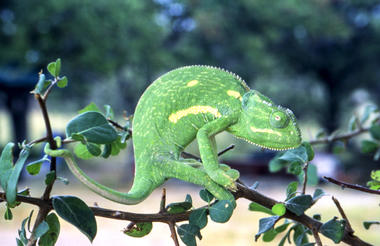
Ghanzi – Okavango Delta (450 km) (FB) (camping)
An early start and a quick stop in Ghanzi to collect any last minute supplies before continuing west, traversing the linear dunes of the Kalahari and passing through small towns along the way. A change in vegetation heralds our arrival on the very western edge of one of the natural wonders of the world, the Okavango Delta. Here we turn north for some way before again pointing our wheels west as we enter the Delta proper.
We see our first glimpse of the crystal waters through the lush vegetation and we make our camp on the banks of a pristine African lagoon.


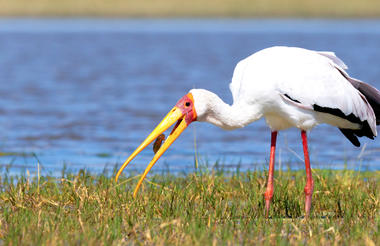
Okavango Delta (FB) (camping)
We are in the territory of the River People, so this morning we leave our vehicle behind and travel in a more appropriate fashion, first by motor-boat and then by traditional Mokoro (dugout canoe), deep into the Delta.
Mokoro’s will be our main form of transport for the next two days. These amazing traditional craft are perfectly designed for the narrow waterways of the Okavango and allow us to travel further into the Delta than if we were using more modern forms of transport.
Mokoro’s carry three people, two seated passengers and one driver. The driver stands in the rear of the canoe, (a real feat of balance), and uses a long wooden pole to propel and steer the Mokoro through the twisting channels. It really is the only way to travel in this area. We are fully self-sufficient and make our camps on the river banks and islands, under huge indigenous trees, sharing the environment with the local people and the local fauna of Africa.
The Okavango is a wildlife paradise and we will look for game from both our Mokoro’s and on bush walks guided by local specialist guides, our polers.
NB: The bathroom facilities in the Okavango Delta can be best described as rustic. There is plenty of water but it is used, straight from the river, (well boiled first). There is no electricity and we will enjoy bucket showers and basic toilet facilities. These conditions will prevail for the two days on the islands.



Mokoro Trips
The traditional dugout canoe, locally known as a mokoro, was the mode of transport chosen by the Okavango’s first inhabitants, the Bayei and Banoka people.
From Guma Lagoon Camp, a 15-minute boat transfer that passes through a narrow meandering channel will get you to the start of your mokoro experience. From here you will get onto a fiberglass or wooden mokoro which can seat two people. The Head Mokoro Poler will then give the group a detailed speech on safety and what to expect on your trip.
You will be poled through the tranquil channels that link the extensive flood plain system to the main river. Water lily beds, palm islands and papyrus stands abound making for the most scenic of experiences. On one of the larger islands you will have time to have your lunch and a guided walk. There is always a chance of seeing large herds of red lechwe bounding through the water and passing elephants feeding amongst the lush wetland vegetation.
Mokoro Trips at Villa Okavango
Okavango Delta (FB) (camping)
Once established into our wilderness routine, we usually take a long, early morning bush walk to see the terrain and hopefully spot some Big Game, returning to camp in the mid-morning for a cooked brunch. There is time to relax in the shade during the heat of the day and from most camps our polers will be able to take us to a safe swimming place to cool off. In the afternoons there is often a shorter walk or a Mokoro cruise in the cool evening air. Sunset from the river is not to be missed.
Okavango Delta (FB) (camping)
The way of life of the Okavango River people has remained largely un-changed for hundreds of years. It is a totally no-stress environment in a pure wilderness setting. We are heading back to our first camp today, gliding across the crystal waters, home to an amazing variety of bird life. There is the chance to add crocodiles and even a hippopotamus to our list of creatures seen before making our final Okavango camp amongst the lush riverine bush.
We will transfer back to camp in the motorboats and aim to be back on the lagoon, with full facilities by the early afternoon. We enjoy a final night beside the unparalleled Okavango waters.
Okavango Delta – Rundu, Namibia (350 km) (BL) (camping)
Back on the road today, destination Namibia. Passport formalities completed we travel on the main road through the Mahango Game Reserve to Bagani. We now head west to our camp for tonight. We are again beside the Okavango, but this time the main river, on its journey from the Angolan highlands, through the pan handle to waters end, the delta.
Dinner tonight will be for the clients own expense in the restaurant at the lodge.
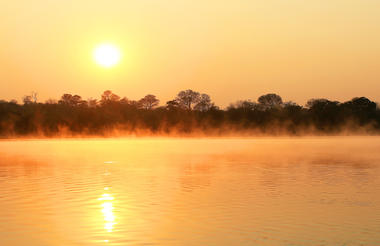
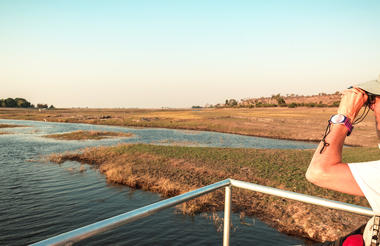
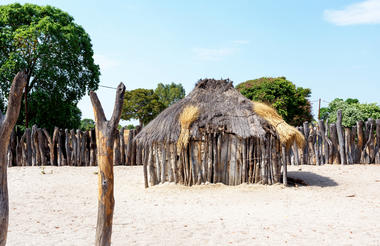
Rundu – Namutoni, East Etosha region (450 km) (FB) (camping)
A short drive brings us to the northern Namibian town of Rundu where there is time to explore the local market before continuing down through the Kavango Region. There are a few breaks along the way at various kraals to see the local crafts and woodcarvings.
Continuing on to our east, we reach Etosha National Park, and the Namutoni region camp. We again aim to arrive in time for lunch, giving us time to relax before heading into the park during the cool of the late afternoon for our first game drive.


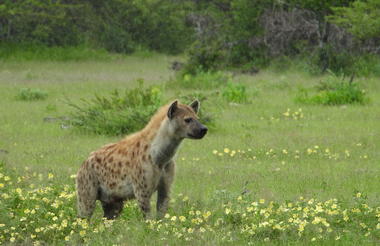
Namutoni, East Etosha region (FB) (camping)
We go straight out on an early morning game drive. We visit some of the numerous waterholes in the area hoping to catch some of Etosha big game out for an early morning drink. The game drives around the Namutoni area are some of the best in the park.
We cover several different terrains this morning, from wooded areas to open savannah and in the rainy season, wetland. Back to Namutoni in the late morning and after lunch there is time once again to relax during the heat of the day. The pool area here is very good, shaded by palm trees and a stone’s throw away from the waterhole.
As on day seven, we take a shorter game drive in the late afternoon, often driving out to one of the waterholes popular with game and waiting for the animals to come to us.

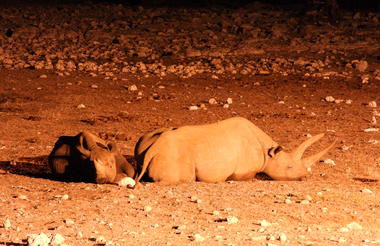

East Etosha region – Okaukuejo, Etosha National Park (FB) (camping)
A full day’s game driving. We again leave early to enjoy the cool morning air. We game drive our way through Etosha to Halali camp, situated in the middle of the park. Along the way we visit several waterholes and are afforded splendid views of the massive Etosha Pan. The game viewing is usually excellent and we have the chance to tick off a few new species that are not normally seen on the Namutoni side of the park.
We stop at Halali for a rest and a leisurely lunch. There is also time to visit the Halali waterhole and to make use of the swimming pool and bar facilities before continuing on our way and game driving down to Okaukuejo camp.
Okaukuejo is famous for its waterhole, which has been described as one of the “best game viewing opportunities in Southern Africa”. Situated on the doorstep of our accommodation, black rhino, elephant, lion and numerous species of antelope are often seen.
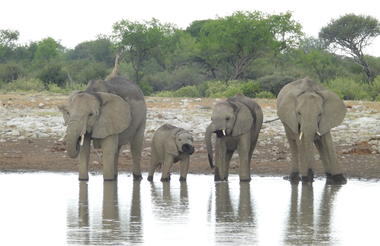
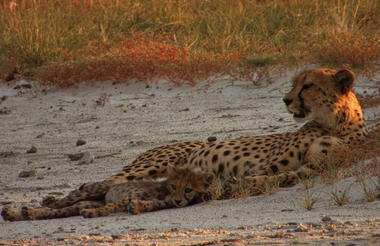
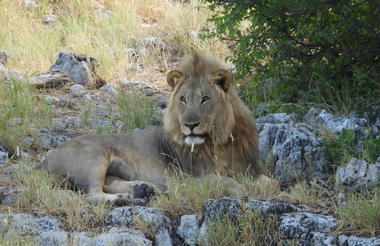
Okaukuejo – Twyfelfontein, Damaraland (400km) (FB) (camping)
Leaving Etosha we are en route for the desert and the most scenic area of our safari. We make a stop at a small town called Outjo where we can get coffee and sticky cakes at the local bakery. We then drive west to Khorixas, the capital of the Damaraland region. A short break here and then, leaving the sealed roads far behind us, we drive into the desert.
We stop for lunch at the Petrified Forest geological site, where a local guide will take us around and explain about the prehistoric trees, before continuing on to Twyfelfontein. Damaraland scenery is some of the best in Namibia, open grasslands studded with massive granite koppies create the feeling of being surrounded by mountains. We are well into desert elephant and black rhino country and other game such as springbok, ostrich and gemsbok are often
seen.
We aim to arrive in the early afternoon and have time to relax in the shade before making a late afternoon excursion to Twyfelfontein itself. Here, again, a local guide will introduce us to the ancient Bushman rock engravings or petroglyphs. We also make a visit to another geological site in the area called the Organ Pipes.



Twyfelfontein – Swakopmund, SkeletonCoast (400 km) (BL) (chalet accommodation)
More beautiful Damaraland scenery this morning. We pass Namibia’s highest mountain, the Brandberg (2573 m) and make our first stop of the morning in the small town of Uis, an old mining town, and one of the best places to buy semi-precious stones, for which Namibia is famous. Here, rough Amethyst, Tourmaline etc. can be found at bargain prices. From here we turn directly west and cross the gravel plains on our way to the Atlantic Ocean and the
Skeleton Coast. Meeting the ocean at Henties Bay, we first head north along the coast to visit the seal colony at Cape Cross. Here at certain times of the year there can be as many as 100,000 Cape Fur seals in attendance.
The next destination is Swakopmund, stopping for lunch en route and following the Skeleton Coast into Namibia’s premier seaside town. Swakopmund boasts a large range of restaurants and cafés, many of them specializing in fish
dishes. The local seafood is superb, taken straight from the icy Atlantic waters. Tonight dinner is for the clients own
account in a local restaurant. Your guide will be able to recommend a venue.
We also make the most of being back in a main centre by leaving the tents loaded and checking into holiday chalets.



General Info:
Situated in northwestern Namibia, the Brandberg (Fire Mountain) Massif is Namibia’s highest peak, at its zenith, the Königstein (King’s Stone), standing at a whopping 2573 metres above sea level. Named for the vivid shade of orange it sometimes turns at sunset, this is undoubtedly the main highlight of the region. The Brandberg has been sacred to the San people for centuries. The Tsisab Ravine at its base is permeated with over 45 000 ancient San rock paintings, including the famous ‘White Lady’. Visitors flock here to view this unique bushman painting, said to be over 2000 years old. Other popular drawcards include its untouched natural beauty and its free roaming wildlife such as mountain zebra, kudu, springbok, and desert elephant.
Swakopmund (B) (accommodated)
Today is a free day. The Swakopmund section of the trip is designed to allow people to relax either with the group, or on their own. Only breakfast is provided to allow you to plan your time here with as much flexibility as possible and not to be tied to group meal times. It also gives you the chance to sample some of the excellent local cafes and restaurants. The seafood in Swakopmund is superb and your guide will offer to organize a group meal in a local
restaurant for this evening.
Swakopmund is a very pleasant seaside town with lots of shops, a good stretch of beach (although the Atlantic here is quite cold) and an open-air curio market. There is also a very good museum and the Namibian National Marine Aquarium is located in Swakopmund.
Alternatively, there are various optional activities that can be arranged. These include aeroplane and microlight flights over the desert, scenic drives, fishing trips (both from the beach or in a boat), four-wheel motorcycle (quad bike) trips into the desert and over the sand dunes around Swakopmund, sand boarding trips (also in the dunes), skydiving, surfing, bird-watching and many other activities are available.
Your tour guide will discuss all the possible options with you before you reach Swakopmund and will offer to make bookings in advance of your arrival.
(N.B. All extra activities and excursions in Swakopmund are subject to availability and are made at the clients’ own risk and expense and dinner this evening is not included in the price of the safari and will be for the client’s own account.)



Swakopmund – Sesriem area (300 km) (FB) (camping)
We first make a stop at Walvis Bay, situated about 40 km south of Swakopmund. South of the town there is a large marine lagoon which is home to a vast array of marine bird-life, in particular flamingos. We will make a short visit to the lagoon to see the birds and a short visit to Walvis Bay to collect any last minute supplies before once again heading out into the desert.
The second part of our journey today takes us across more of the seemingly endless Namib gravel plains. Then the landscape suddenly changes and we are into the mountain desert. We traverse both the Kuiseb and Gaub passes, driving both times to the river beds at the bottom of the canyons and then climbing the long steep road to the top and the spectacular panoramas the mountains give us. Again the scenery changes as we make our way down to the
dune fields.
We cross some open grass savannah and farmlands before the terrain begins to give way to the immense red sand dune desert of the Namib and from here it is only a short distance to our next stop, the tiny town of Solitaire. We will stop here for some refreshments before continuing on through stunning desert scenery.
We aim to arrive at our camp during the late afternoon and watch the colours glow and change on distant mountains to the east.
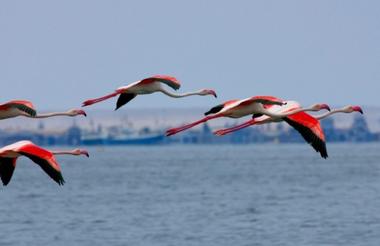
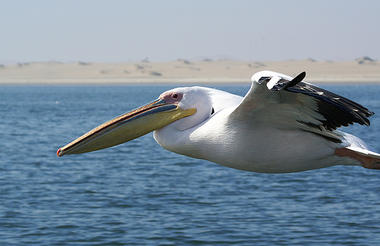
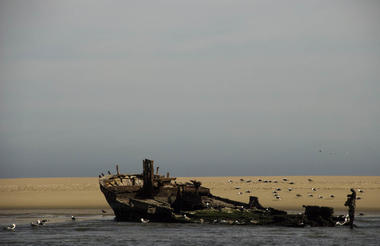
Sesriem area – Sossusvlei – Sesriem area, (camping) (FB)
A pre-dawn start is essential this morning as we want to catch the soft light of the sunrise on the desert. After passing through Sesriem, the gateway to the dunes and driving into the heart of the dune field, we reach Sossusvlei itself by walking the last 5 km through the dunes.
The walk is like nothing else, in the cool of the morning, with soft sunlight just beginning to play over the dunes creating a sharp light and shadow contrast across the whole desert. Ancient mineral pans, stunted camel thorn trees and the chance of seeing a gemsbok or maybe an ostrich make the photo opportunities perfect. We spend the morning in and around Sossusvlei, also visiting dune 45, and as the day wears on we return to Sesriem for lunch to escape the heat of the afternoon. As the day cools off in the late afternoon we will take a short excursion to the Sesriem Canyon.
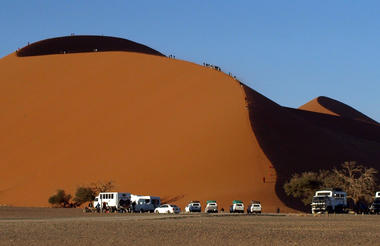

Sesriem area – Windhoek (450 km) (BL)
After breakfast we begin our journey, over the mountains and along scenic roads, back to Windhoek. In the Solitaire area we will stop at the ‘N/a’an ku se Namib Conservation Centre’, a 500 hectare Conservation Centre which hosts an educational centre and wildlife tracking within the purpose built enclosures and receive information on the carnivore surveillance in the greater Namib area.
We will travel over the Naukluft Mountains and also the Khomas Hochland range, through beautiful Remhoogte Pass on our way back to civilization.
We are due back into the city in the late afternoon / early evening , you will be dropped off at your accommodation on our return. Alternatively we can arrange for you to be taken to the International Airport if you are catching an evening flight.
The Namib Carnivore Conservation Centre promotes the rehabilitation and reintroduction of large carnivores into the area, in particular cheetahs. This provides guests with the opportunity to accompany the field biologists on wild cheetah tracking safaris.





